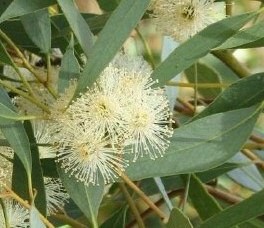Karri
(Eucalyptus diversicolor)

Description
Eucalyptus diversicolor, commonly known as karri, is a species of flowering plant in the family Myrtaceae and is endemic to the south-west of Western Australia. It is a tall tree with smooth light grey to cream-coloured, often mottled bark, lance-shaped adult leaves and barrel-shaped fruit. Found in higher rainfall areas, karri is commercially important for its timber. Eucalyptus diversicolor is a tall forest tree that typically grows to a height of 10–60 m (33–197 ft) but can reach as high as 90 m (300 ft), making it the tallest tree in Western Australia and one of the tallest in the world. As of February 2019, the tallest known living karri is just over 80m tall. A tree south of Pemberton, known as 'The Tyrant' is 69m tall and 11.5m in girth and contains approximately 220m³ of wood in its trunk and is thought to be the largest karri by wood volume. The bark on the trunk and branches is smooth, grey to cream-coloured or pale orange, often mottled and is shed in short ribbons or small polygonal flakes. The leaves on young plants and on coppice regrowth are arranged in opposite pairs, broadly egg-shaped to almost round, paler on the lower surface, 50–155 mm (2.0–6.1 in) long, 25–100 mm (0.98–3.94 in) wide and petiolate. Adult leaves are arranged alternately, glossy dark green on the upper surface, paler below, lance-shaped, 70–135 mm (2.8–5.3 in) long and 15–37 mm (0.59–1.46 in) wide on a flattened or channelled petiole 10–20 mm (0.39–0.79 in) long. The flower buds are arranged in groups of seven in leaf axils on a rounded peduncle 12–30 mm (0.47–1.18 in) long, each bud on a pedicel 3–6 mm (0.12–0.24 in) long. The buds are oval, 11–16 mm (0.43–0.63 in) long and 5–7 mm (0.20–0.28 in) wide at maturity with a conical operculum. Flowering has been observed in January, April, May, August and December, and the flowers are white. The fruit is a woody barrel-shaped capsule 10–12 mm (0.39–0.47 in) long and 8–10 mm (0.31–0.39 in) wide on a pedicel 5–6 mm (0.20–0.24 in) long with three valves at or below rim level. Eucalyptus diversicolor was first formally described in 1863 by the botanist Ferdinand von Mueller in his book Fragmenta Phytographiae Australiae.The type specimen was collected in 1860 by the botanist Augustus Frederick Oldfield near Wilson Inlet, the location given, in Latin, is In Australiae regionibus depressioribus quam Maxime austro occidentalibus, ubi Blue Gum-tree vocatur.
Taxonomic tree:







